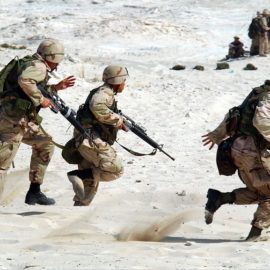

This article is an excerpt from the Shortform book guide to "American Marxism" by Mark R. Levin. Shortform has the world's best summaries and analyses of books you should be reading.
Like this article? Sign up for a free trial here.
What’s social movement theory? How is it being taught in schools? Is it part of an indoctrination machine—or even worse?
Mark Levin believes that the teaching of social movement theory is part of a program of Marxist indoctrination in schools. He argues that it goes as far as encouraging revolution.
Keep reading to understand the theory and Levin’s take on it.
Marxist Indoctrination in Schools
Levin argues that the first step of Marxist indoctrination in America involves the education system. These institutions are led by leftist professors who encourage students to engage in mass movements and rebellions against America.
Levin explains that many of the lessons currently taught in schools center around leftist ideologies and perspectives that are framed as moral truths, like Critical Theory and social movement theory. He believes that these ideologies are dangerous because they encourage discontentment with the American government, society, economy, and overall way of life. They teach students that American society and history are inherently unjust and evil and that social activism and rebellion are the only remedies.
Let’s take a look at social movement theory and why Levin believes it threatens American society.
Social Movement Theory
Social movement theory explores why social movements form, how they develop, and their effects on society, culture, and politics. Levin believes that it amounts to Marxist indoctrination in schools. He claims that the theory is more actionable and incentivizing than it is educational—it paints mass movements and revolutions as an honorable and virtuous response to “oppressive” societies.
Drawing on the 1992 book Frontiers in Social Movement Theory, Levin claims that the theory encourages and teaches students how to rise up against the wealthy elite in protest and revolution. Not only does it instruct students on how to organize and execute a revolution, but it also glamorizes these events. The theory presents revolution as a righteous means to weaken and eventually abolish the structures of political and social domination that are to blame for inequality and injustice. And Levin argues that, while the theory claims to encourage peaceful protests, it’s also the basis for violence, riots, and revolution.
So, while Critical Theory provides youths with societal grievances to rebel over, Levin says that social movement theory is essentially the rulebook that encourages and instructs youths on exactly how to revolt—not only is the American education system indoctrinating students with left-wing ideology, but it’s encouraging revolution.
| New Social Movement Theory Levin claims that SMT is dangerous because it glamorizes revolution and teaches students how to overthrow social and political structures, and he cites the 1992 book Frontiers in Social Movement Theory to support his claims. While Frontiers was a credible source for its time, a new social movement theory has dominated the field in the 30 years between its publication and the publication of American Marxism. This new theory, called “new social movement theory,” contests older theories contained in Frontiers that take a primarily Marxist standpoint, like resource mobilization theory. Resource mobilization theory suggests that the success of movements is fundamentally connected to class and economic factors. It claims that the more resources (money, supplies, social connections, and political power) organizations have, the more likely their movements are to succeed. New social movement theory (NSMT) suggests that this approach no longer applies to postmodern movements. NSMT claims that rather than struggling against access to resources, postmodern movements struggle against non-economic factors like social inequality (including racial inequality), the dominance of mass media, and other elements of post-industrial capitalism and the welfare state. Since Levin only addresses older SM thought contained within Frontiers, it’s unclear whether or not he would maintain that NSMT also glamorizes and encourages students to overthrow social and political institutions—especially since NSMT resists the primarily Marxist view that social movements struggle against power structures like class and economic control. |

———End of Preview———
Like what you just read? Read the rest of the world's best book summary and analysis of Mark R. Levin's "American Marxism" at Shortform.
Here's what you'll find in our full American Marxism summary:
- Why Mark Levin thinks leftist organizations are fueling a Marxist revolution
- Who the American Marxists are and what ideologies they’re pushing
- What American patriots can do to maintain their freedom






